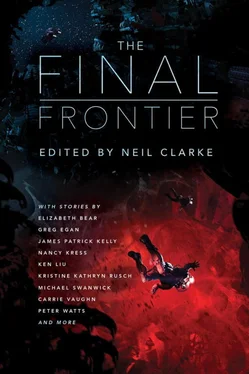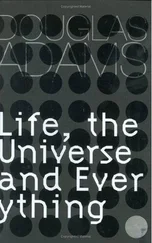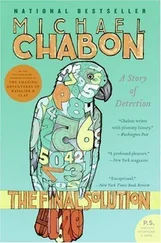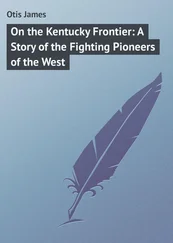“Yes.”
“Do you consent?”
“I consent.”
“Do you further consent to acknowledge this child and to assist in its rearing on the planet Guge, as well as on this ship?”
He considered these queries. And, smiling, he agreed.
“Then we may advance to the third exalted initiation,” I said, “that of the mutual experience of connate joy.”
I slid backward over the pliable warmth of his standing phallus and kissed him in the middle of his chest. He reached for me, tenderly, and the AG generators abruptly cut off—suspiciously, it seemed to me. I floated toward the ceiling like a buoyant nixie, too startled to yelp or laugh. Jetsun shoved off in pursuit, but hit a bulkhead and glanced off it horizontally.
It took us a while to reunite, to find enough purchase to consummate our resolve, and to do so honoring the fact that a resurgence of gravity could injure, even kill, both of us. Nonetheless, we managed, and managed passionately.
The ‘night’ has now passed. Jetsun sleeps, mind eased and body sated.
I sit at this console, lock-belted in, recording the most stirring encounter of my life. Every nerve and synapse of my body, and every scrap of assurance in my soul, tell me that Jetsun and I have conceived: Alleluia.
YEARS IN TRANSIT: 100
COMPUTER LOGS OF OUR RELUCTANT DALAI LAMA, AGE 25
Some history: Early in our voyage, when our AG generators worked reliably, our monks created one sand mandala a year. They did so then, as they do now, in a special studio in the Yellow Hat gompa in U-Tsang. They kept materials for these productions—colored grains of sand, bits of stone or bone, dyed rice grains, sequins—in hard plastic cylinders and worked on their designs over several days. Upon finishing the mandalas, our monks chanted to consecrate them and then, as a dramatic enactment of the impermanent nature of existence, destroyed them by sweeping a brush over and swirling their deity-inhabited geometries into inchoate slurries.
These methods of creating and destroying the mandalas ended four decades into our flight when a gravity outage led to the premature disintegration of a design. A slow-motion sandstorm filled the studio. Grains of maroon, citron, turquoise, emerald, indigo, and blood-red drifted all about, and recovering these for fresh projects required the use of hand-vacs and lots of fussy hand-sorting. Nobody wished to endure such a disaster again. And so, soon thereafter, the monks implemented two new procedures for laying out and completing the mandalas.
One involved gluing down the grains, but this method made the graceful ruination of a finished mandala dicey. A second method involved inserting and arranging the grains into pie-shaped plastic shields using magnets and tech-manipulated “delivery straws,” but these tedious procedures, while heightening the praise due the artists, so lengthened the process and stressed the monks that Sakya Gyatso ceased asking for annual mandalas and mandated their fashioning only once every five years.
In any case, today marks our one-hundredth year in flight, and I am fat with a female child who bumps around inside me like those daredevils in old vidped clips who whooshed up and down the sloped walls of special competition arenas on rollers called skateboards.
I think the kid wants out already, but Karma Hahn, my baby doc, tells me she’s still much too small to exit, even if the kid does carry on like ‘a squirrel on an exercise wheel.’ That metaphor endears both the kid and Karma to me. Because the kid moves, I move. I stroll about my private audience chamber, aka ‘The Sunshine Hall,’ in the Potala Palace in U-Tsang. I’ve voluntarily removed here to show my fellow Buddhists that I am not ashamed of my fecund condition.
Ian announces a visitor, and in walks First Officer Nima Photrang, whom I’ve not seen for weeks. She has come, it happens, not solely to visit me, but also to look in on an uncle who resides in the nearby Yellow Hat gompa. She has brought a khata, a white silk greeting scarf, even though I already have enough of these damned rags to stitch together a ship cover for the Kalachakra. She drapes it around my neck. Laughing, I pull it off and drape it around hers.
“Your design contest spurs on every amateur-artist ghost in Amdo and Kham,” Nima says. “If you wish your mandala to further community enlightenment by projecting an image of our future Palace of Hope on Guge, well, you’ve got a lot of folks worrying away at it—mission fully goosed, if not yet fully cooked.”
I realize that Sakya Gyatso, my predecessor, his eye on Tibetan history, called the world toward which we relentlessly cruise ‘Guge,’ partly for the g in Gliese 581g. What an observant and subtle man.
“Nima,” I ask, “have you submitted a design?”
“No, but you’ll probably never guess who intends to.”
No, I never will. I gape cluelessly at Nima.
“Captain Xao Songda, our helmsman. He spends enormous chunks of time with a drafting compass and a pen, or at his console refining design programs that a monk in U-Tsang uploaded a while back to Pemako.”
Pemako is the latest version of our intranet. I like to use it. Virtually nightly (stet the pun), it shows me deep-sea sonograms of my jetting squid-kid.
“I hope Captain Xao doesn’t expect his status as our shipboard Buzz Lightyear to score him any brownies with the judges.”
Nima chortles. “Hardly. He drew as a boy and as a teenager. Later, he designed maglev stations and epic mountain tunnels. He figures he has as good a chance as anyone in a blind judging, and if he wins, what a personal coup!”
“Mmm,” I say.
“No, really, you’ve created a monster, Your Holiness—but, as one of the oldest persons aboard, he deserves his fun, I guess.”
We chat some more. Nima asks if she may lay her palm on the curve of my belly, and I say yes. When the brat-to-be surfs my insides like a berserk skateboarder, Nima and I laugh like schoolgirls. By some criteria, I still qualify.
YEARS IN TRANSIT: 101
COMPUTER LOGS OF OUR RELUCTANT DALAI LAMA, AGE 25-26
I return to Amdo to deliver my child. Early in the hundred and first year of our journey, my water breaks. Karma Hahn, my mother, and Alicia and Emily Paljor attend my lying-in, while my father, Ian Kilkhor, Minister Trungpa, and Jetsun perform a nervous do-si-do in an antechamber. I give the guys hardly a thought. Delivering a kid requires stamina, a lot of Tantric focus, and a cooperative fetus, but I’ve got ‘em all and the kid slams on out in under four hours.
I lie in a freshly made bed with my squiddle dozing in a warming blanket against my left shoulder. Well-wishers and family surround us like sentries, although I have no idea what they’ve got to shield us from: I’ve never felt safer.
Mama says, “When will you tell us the ruddy shrimp’s name? You’ve kept it a secret eight months past forever.”
“Ask Jetsun. He chose it.”
Everyone turns to Jetsun, who at twenty-one looks like a fabled Kham warrior, lean and smooth-faced, a flawless bronze sculpture of himself. How can I not love him? Jetsun looks to me. I nod.
“It’s… it’s Kyipa.” Like the sweetheart he is, he blushes.
“Ah,” Nyendak Trungpa sighs. “Happiness.”
“If we all didn’t strive so damned hard for happiness,” Daddy says, “we’d almost always have a pretty good time.”
“You stole that,” Mama rebukes him. “And your timing sucks.”
From behind those crowded about my babe-cave, a short, sturdy, gray-haired man edges in. I know him as Alicia Paljor’s father, Emily Paljor’s husband—but Daddy, Ian, and Neddy know him as the chief fuel specialist on our strut-ship and thus a personage of renowned ability. So I assume he’s come—like a wise man—to kneel beside and to adore our newborn squiddle. Or has he come just to meet his wife and daughter and fetch them back to their stateroom?
Читать дальше












